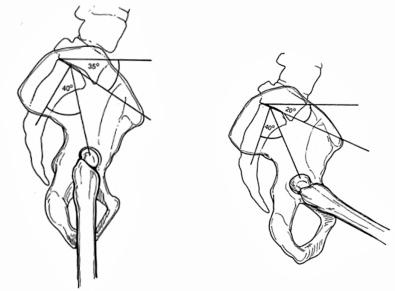Physical Address
304 North Cardinal St.
Dorchester Center, MA 02124
The normal stand-to-sit postural change is 20 degrees of posterior pelvic tilt and 55 to 70 degrees of femur flexion—not 90 degrees of hip flexion.
Stand-to-sit mobility involves two hinges: the posterior hinge is the lumbosacral junction (sacral slope), and the anterior hinge is the hip. Stiffness of one requires increased motion of the other.
For total hip arthroplasty, a stiff lumbosacral junction means that the pelvic motion is decreased, which requires increased motion of the femur that can lead to impingement of the hip and dislocation.
To understand the impact of spinopelvic imbalance for any patient requires obtaining lateral spine-pelvic-hip radiographs and then appropriate cup position at surgery.
Once patients are over 60 years of age, and especially 70 years, the greater is the occurrence of a stiff lumbosacral posterior hinge and, therefore, an increased risk of impingement because femur motion will be above normal.
Accurate and precise component positioning in total hip arthroplasty (THA) is a ubiquitous goal among hip surgeons and an important topic of research. Early studies defined a “safe zone” for placement of the acetabular cup; divergence from the defined safe zone was shown to predispose patients to dislocation. However, ideas regarding the position of the acetabular cup have continued to evolve beyond the initial description by Lewinnek in 1978. DiGioa et al. described functional cup position, rather than just anatomic inclination and anteversion, as being the angles of the acetabulum that correlated to the axis of the body, using lateral radiographic measurements of the spine, pelvis, and hip. This expanded definition was the first to consider spinal parameters as part of a functional spine-pelvis-hip relationship. Lazennec et al. in France used a new imaging modality (EOS, Biospace Med, Paris, France) to clearly demonstrate the interrelationship of spinal mobility to acetabular position during postural change of sitting to standing ( Fig. 75.1 ). This research increased our understanding that spine-pelvis-hip motion is synchronized for the purpose of allowing the normal hip to move freely through its arc of motion without the greater trochanter impinging on the pelvis or the lesser trochanter on the ischium. As hip surgeons learned more about the anatomy of this spine-pelvis-hip relationship, research shifted to studying the effect of this relationship on outcomes following THA. The cumulative effect of that work has been to redefine the safe zone for acetabular component positioning by taking into account spinopelvic motion. This chapter will focus on the evolving definition of an acetabular safe zone in the context of the spine-pelvis-hip construct and on how to personalize and optimize component positioning based on patient-specific spinopelvic parameters.

Become a Clinical Tree membership for Full access and enjoy Unlimited articles
If you are a member. Log in here